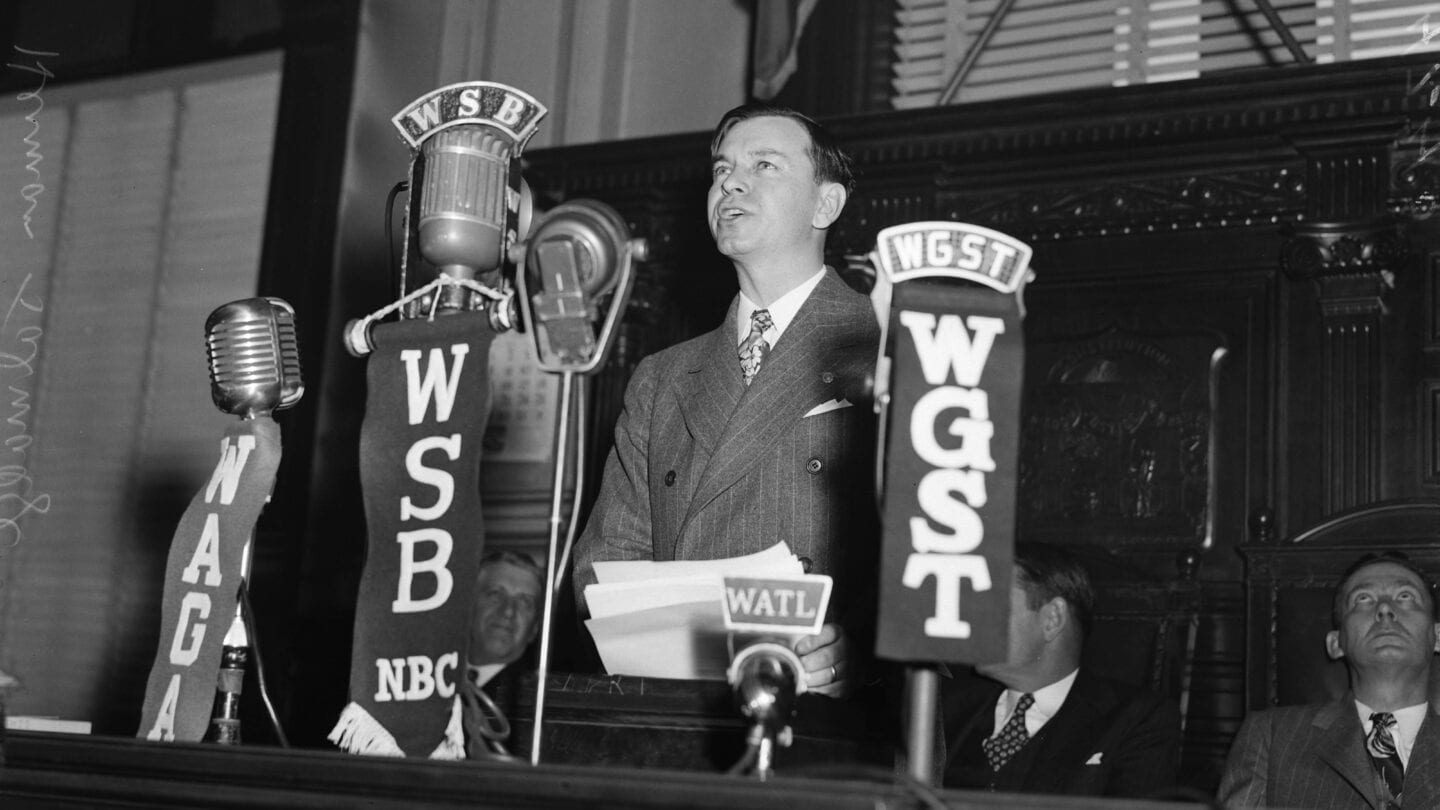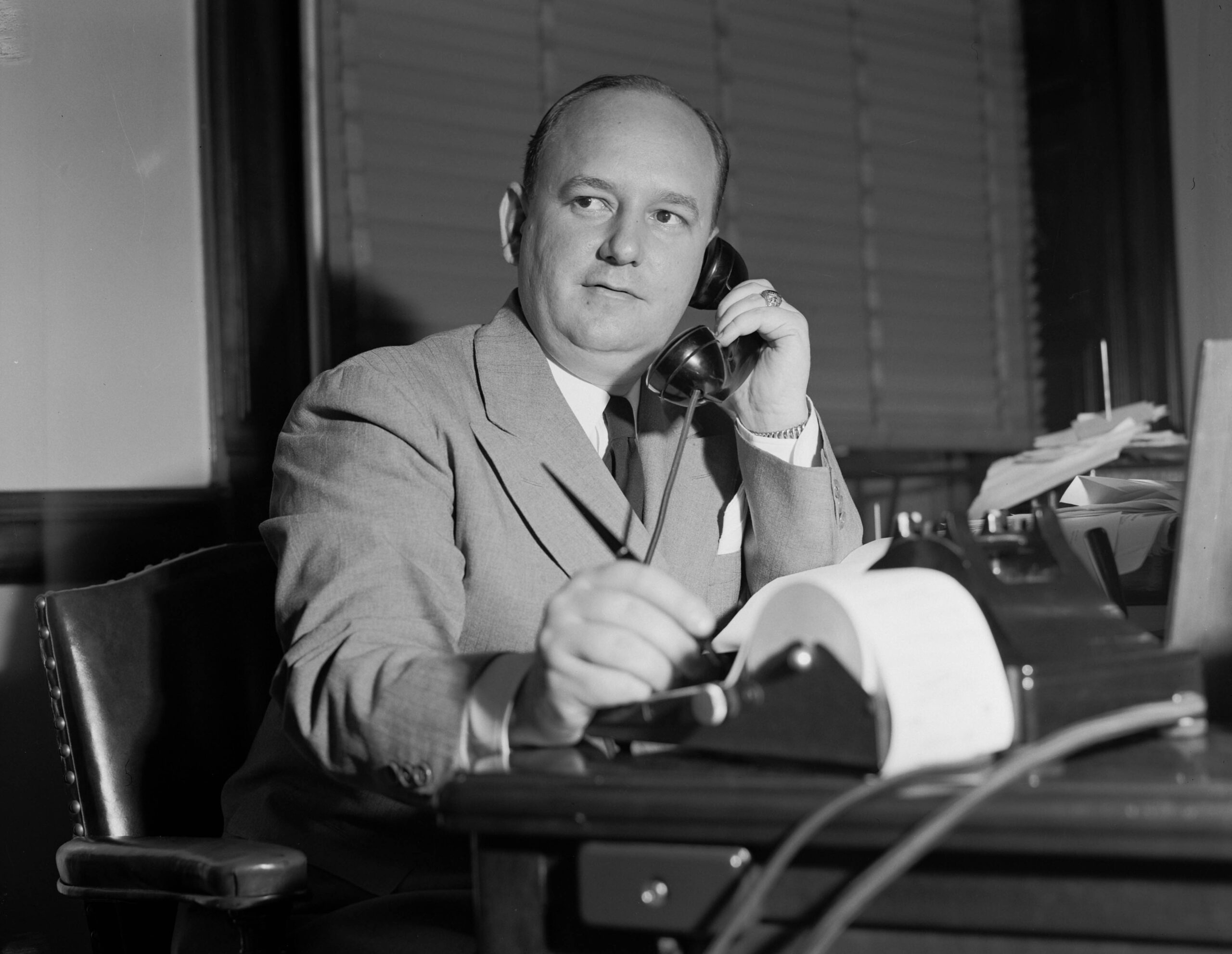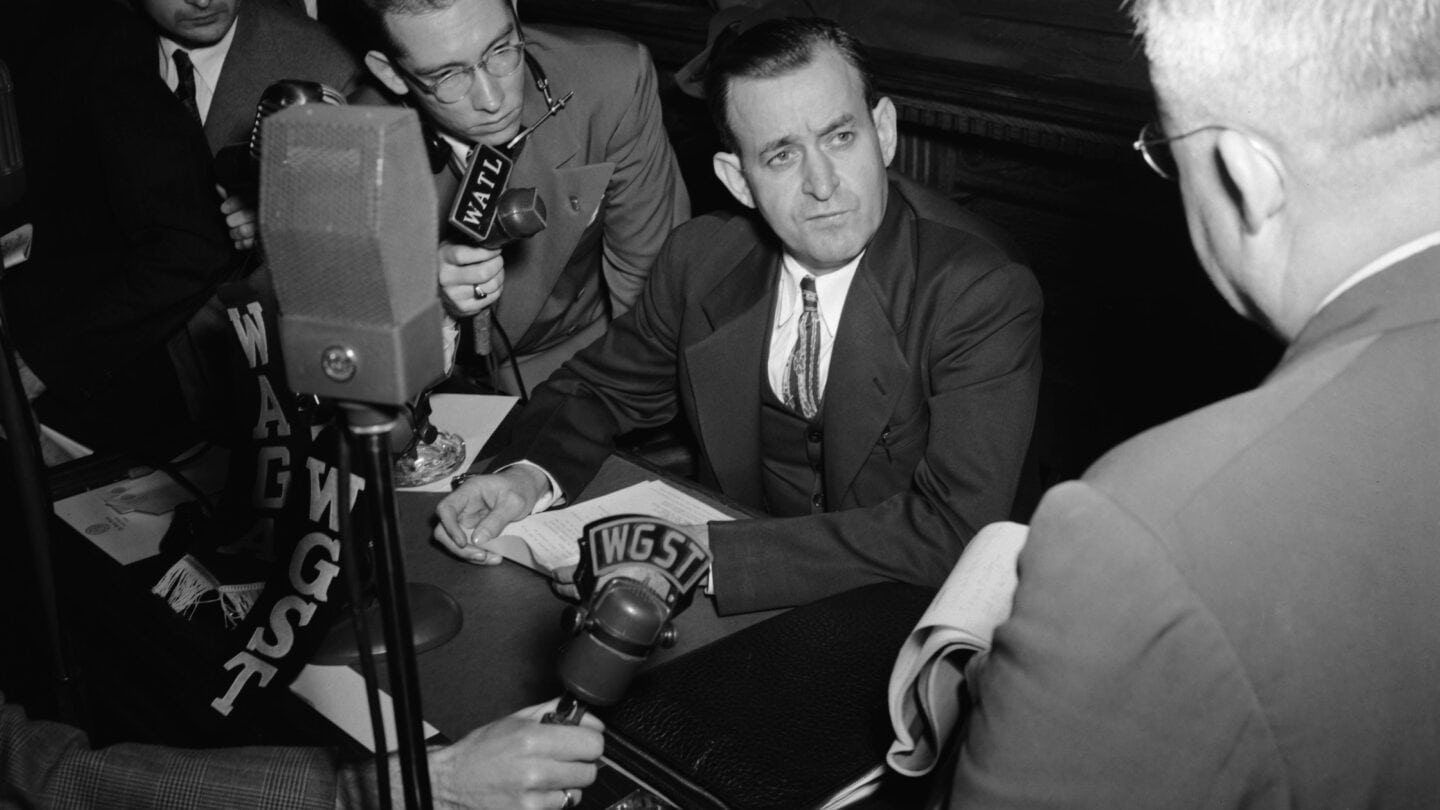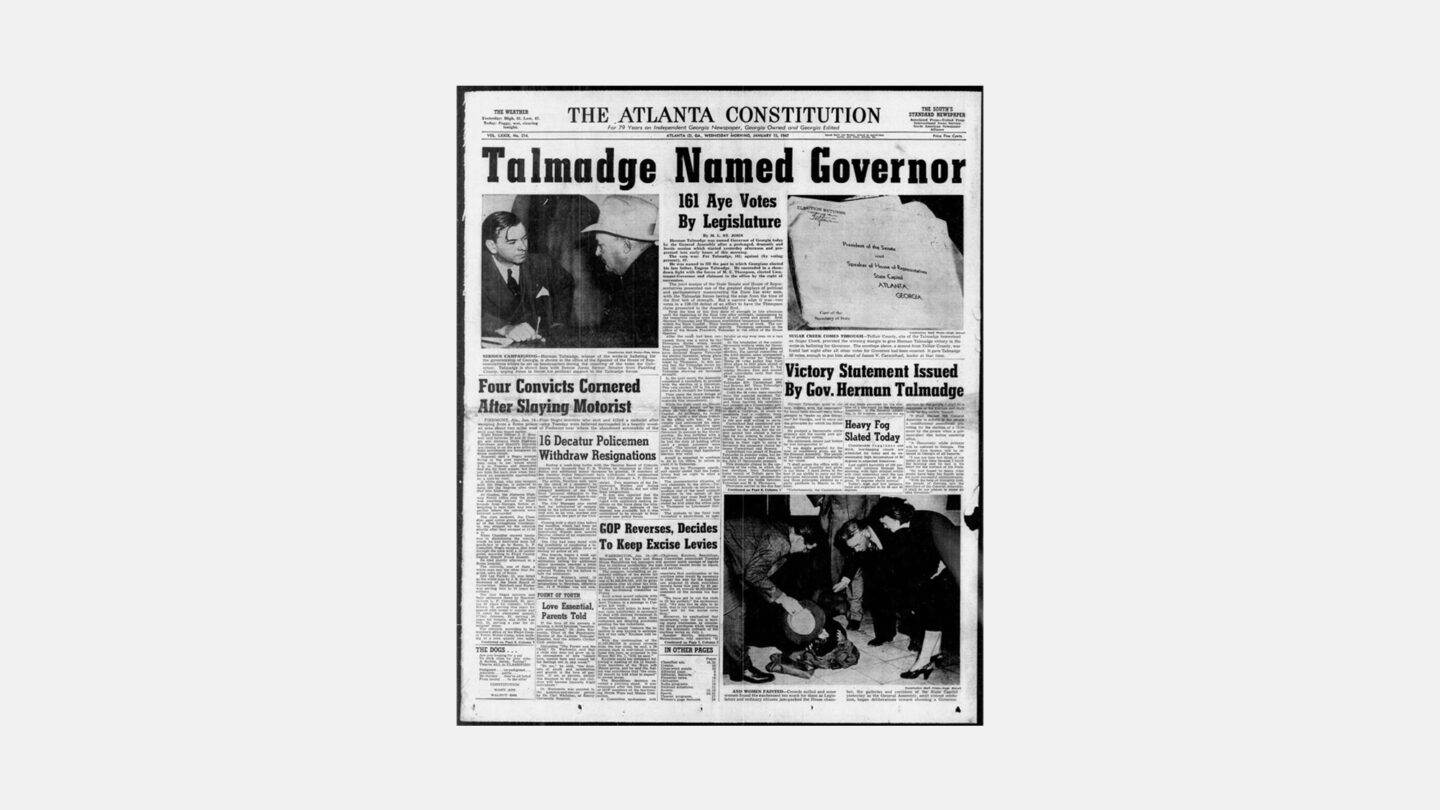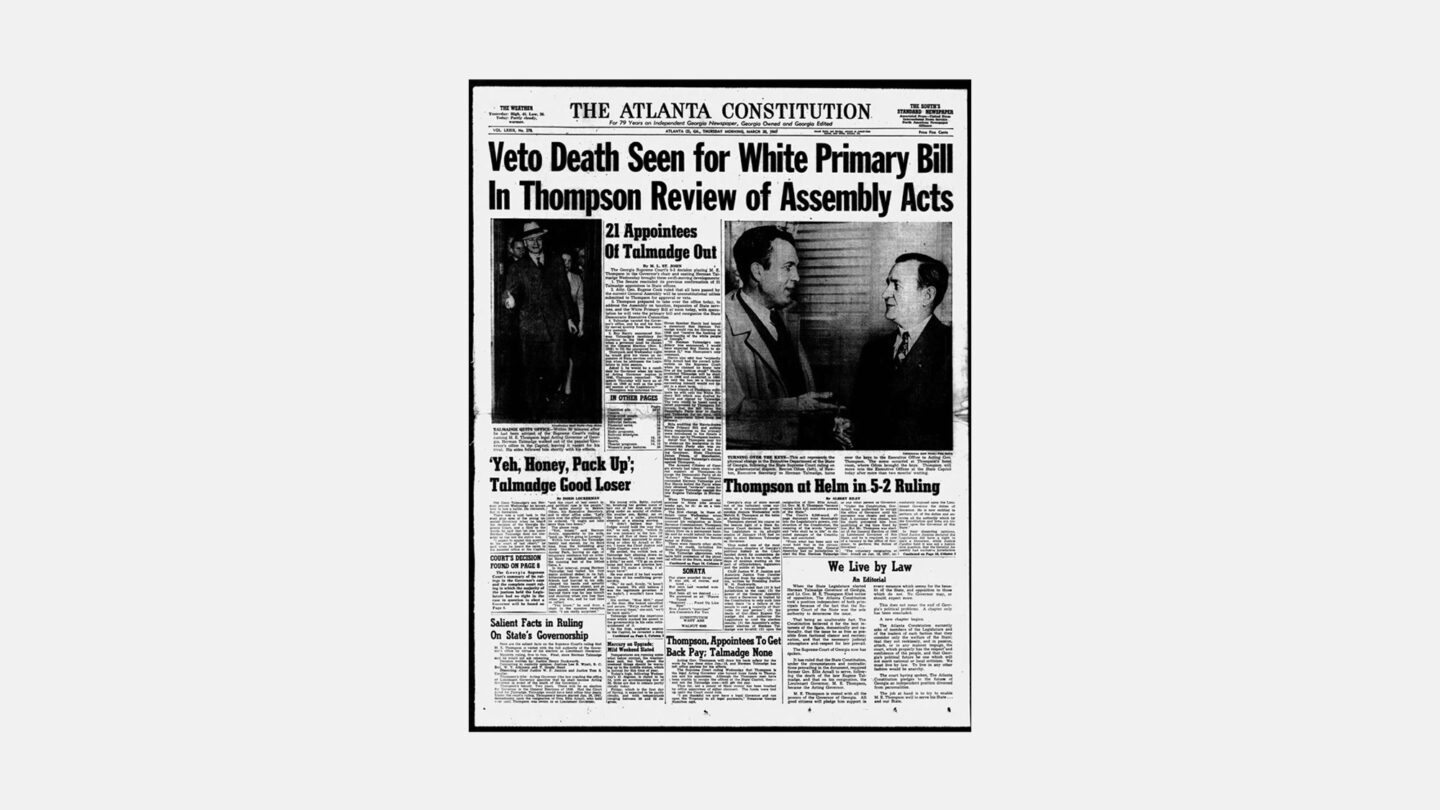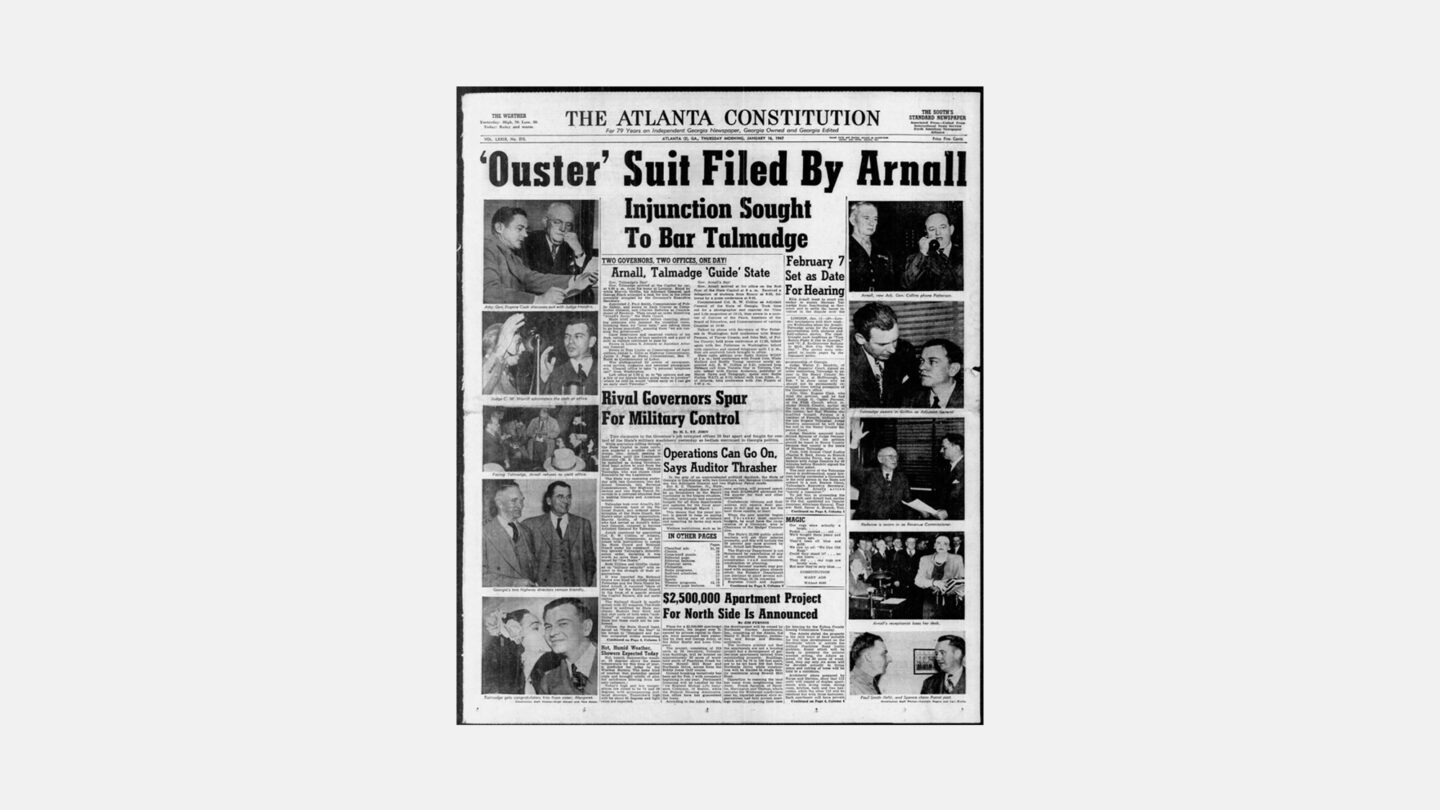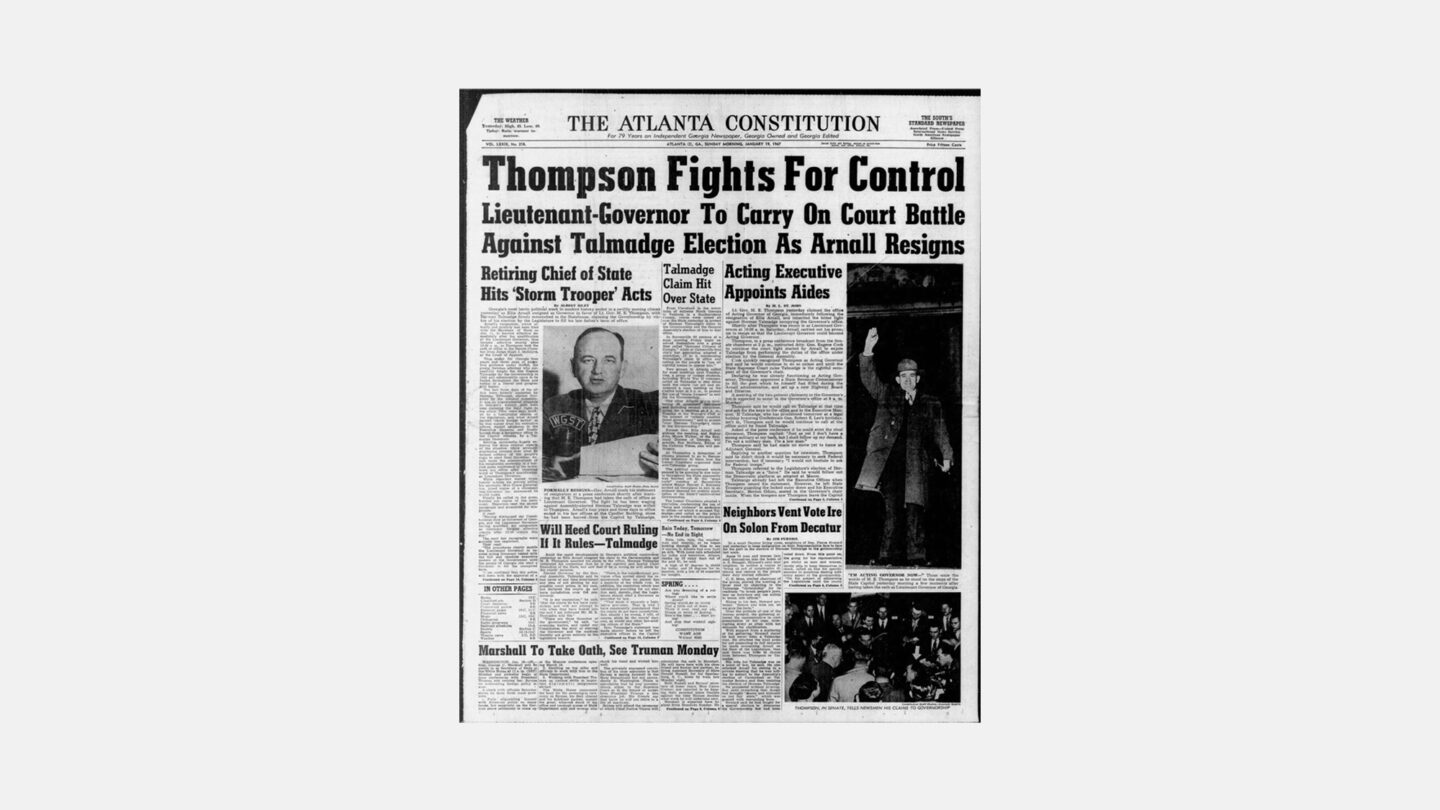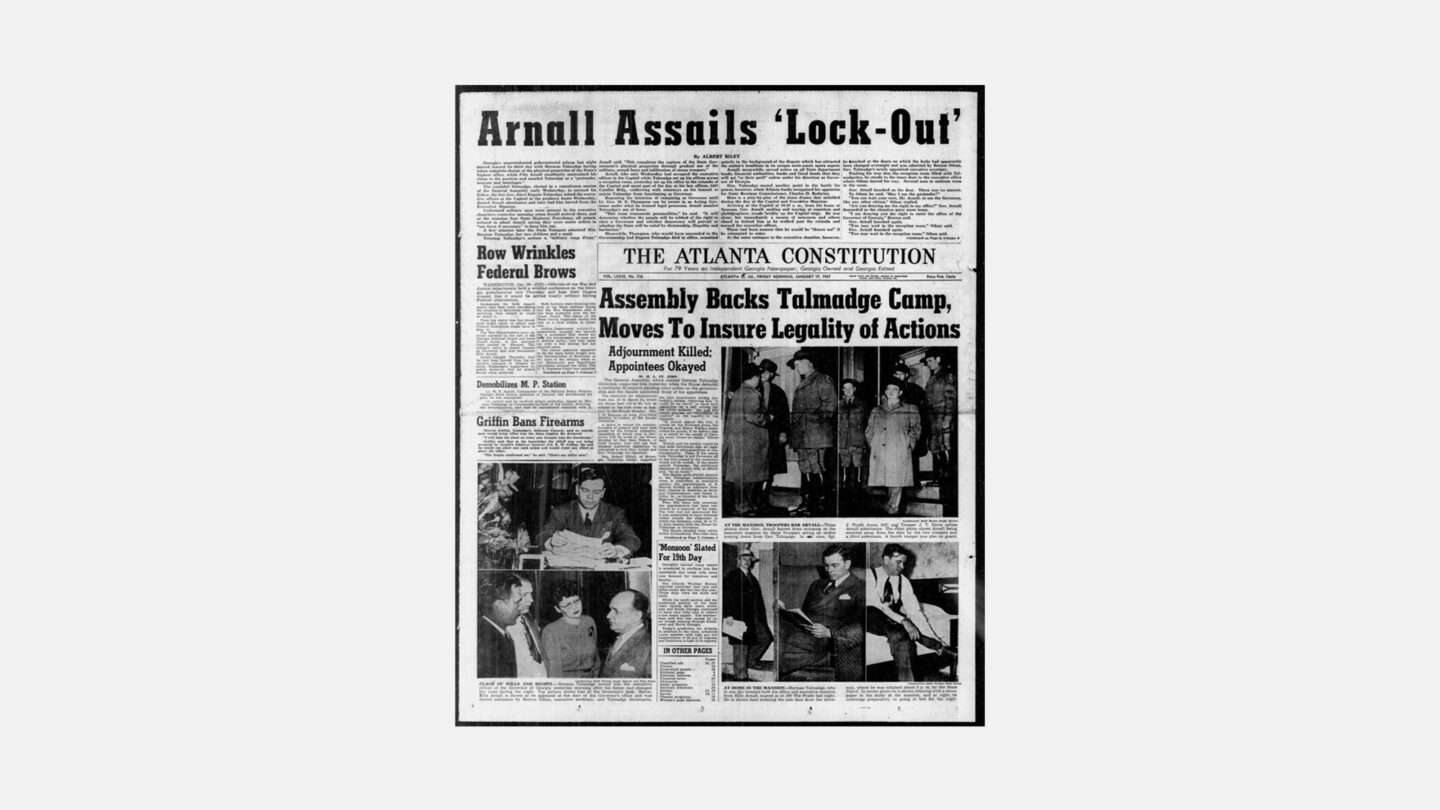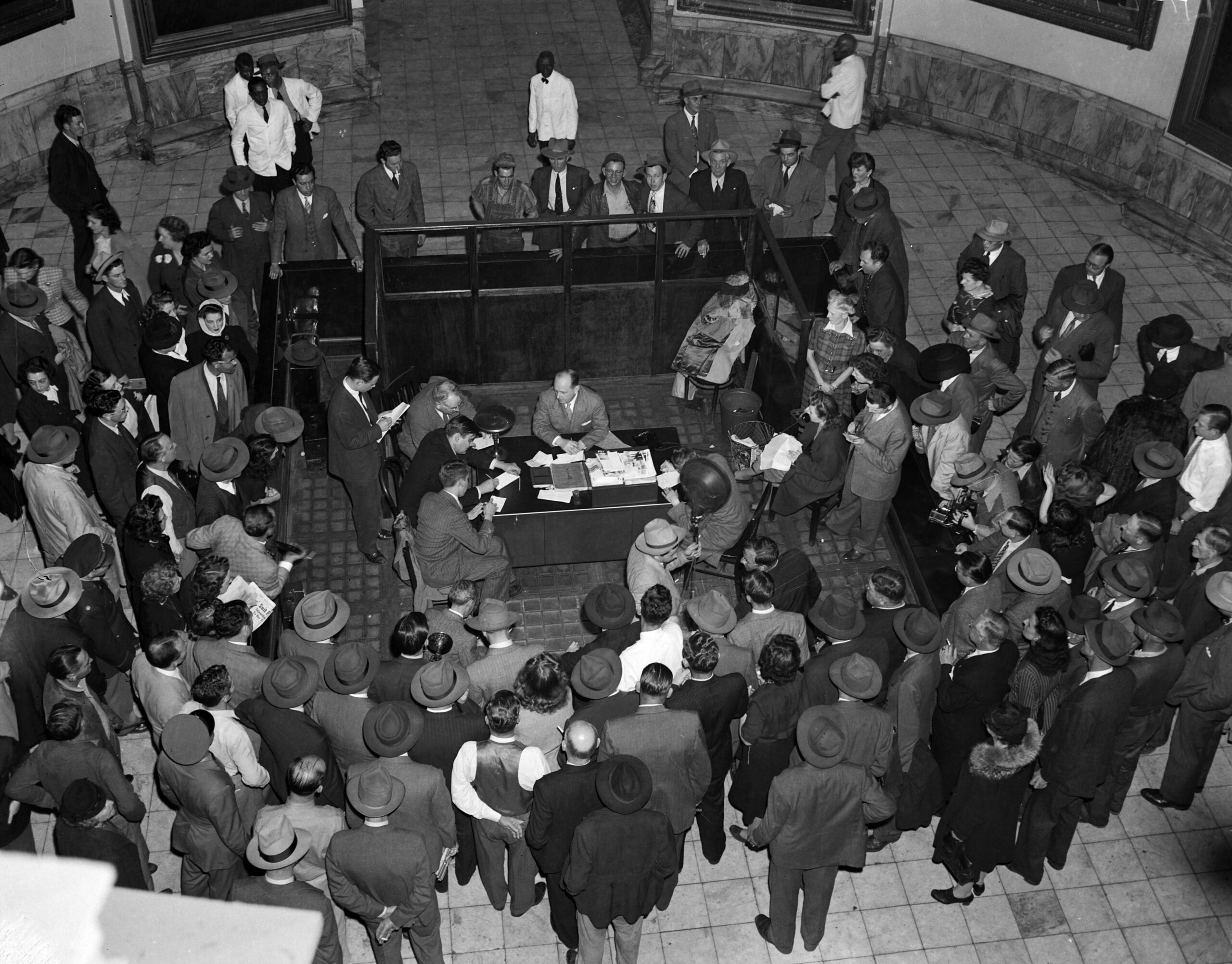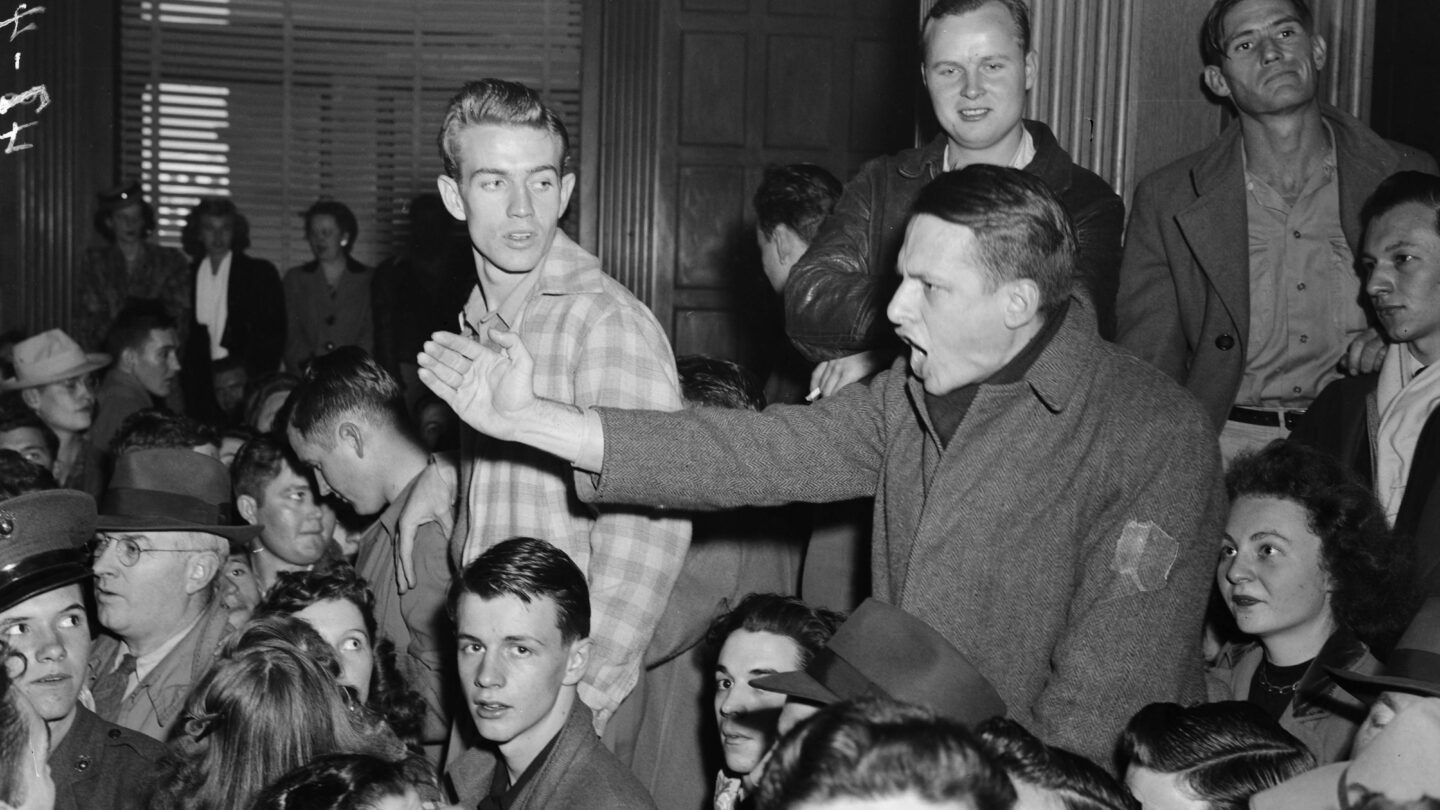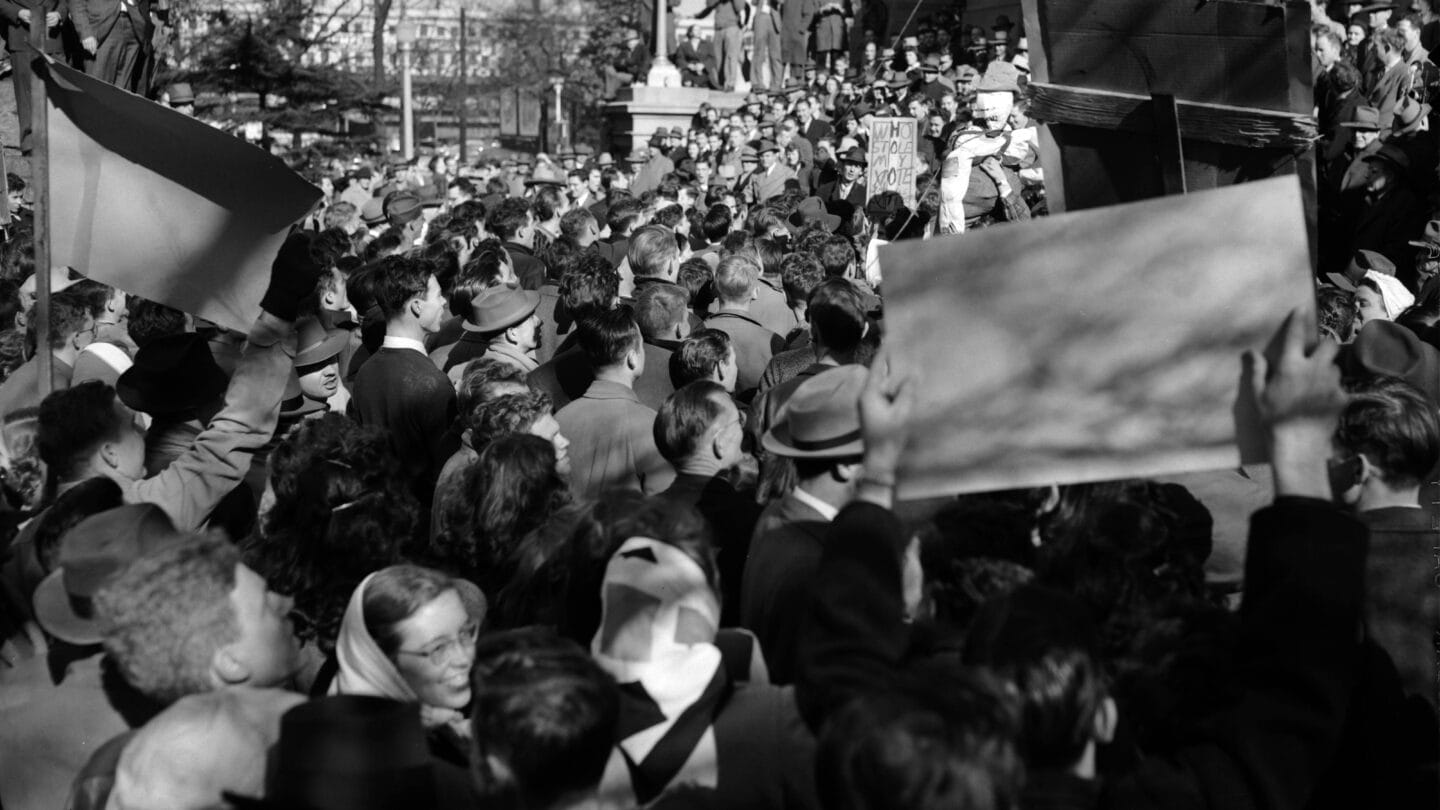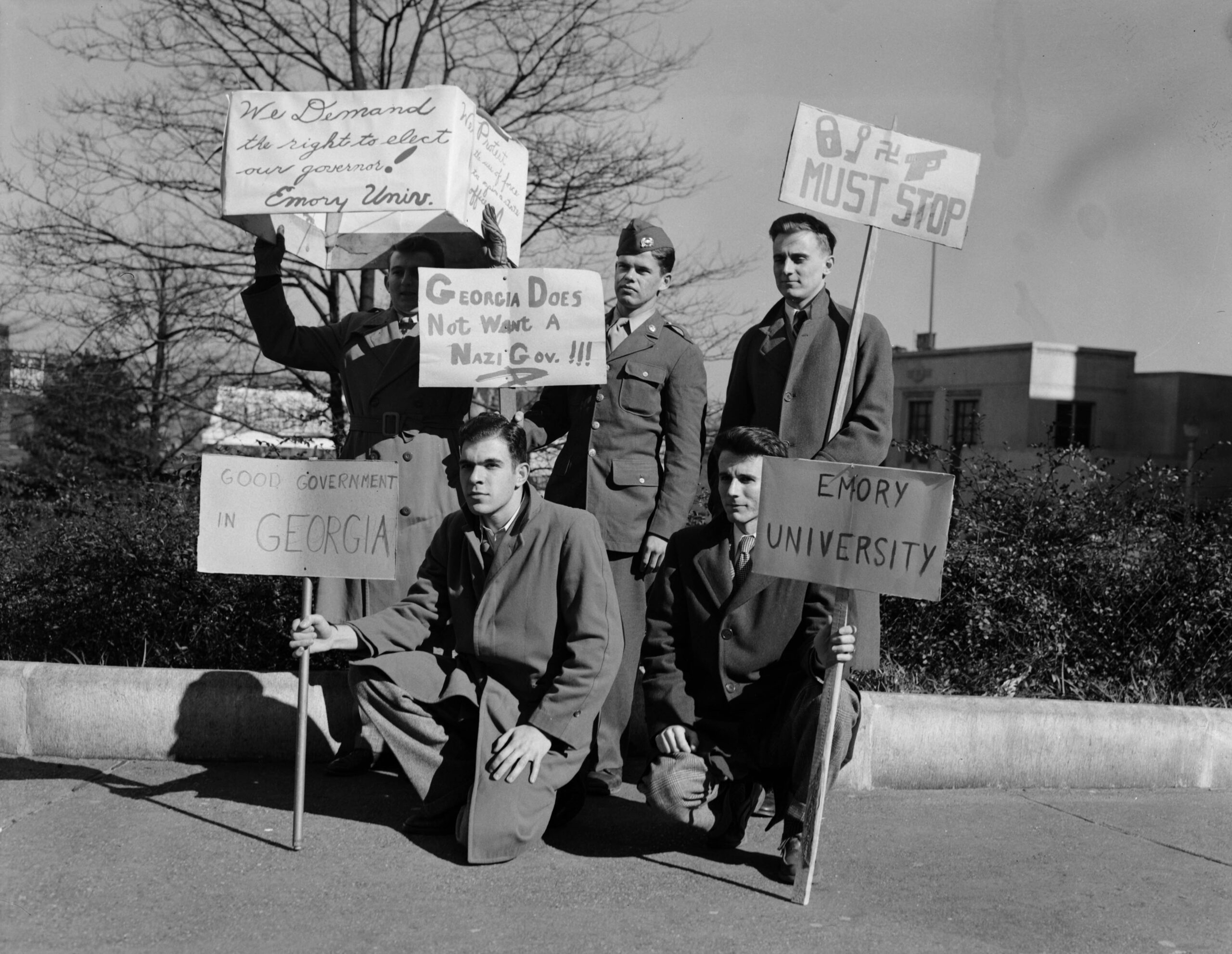
Emory University students protest outside the State Capitol during the Three Governors Controversy. | VIS 33.05.05, Marion Johnson Photograph Collection, Kenan Research Center, Atlanta History Center
For a brief and tumultuous few weeks in 1946 and 1947, Georgia had three governors. The ordeal was bizarre and captured the imaginations of newsreel-watchers across the country. Governor-elect Eugene Talmadge died before he was sworn into office and his death plunged the state into turmoil. What followed is political legend—ballot tampering, political dynasty, fist fights, and Pulitzer Prize-winning journalism.
The Georgia Gubernatorial Election of 1946
The 1946 governor’s race saw three-term governor Eugene “Gene” Talmadge sparring with James V. Carmichael. Talmadge, whose previous time in office was replete with corruption, ran on a platform based on white supremacy. During his first three terms in office (1933-1937; 1941-1943), Talmadge employed nepotism, stacking the state’s payroll with relatives and close friends. He gave gifts to constituents and legislators from the state’s rural districts and racked up hundreds of thousands of dollars of personal expenditures in today’s figures.

View of Georgia Governor Eugene Talmadge delivering a speech in Georgia. | VIS 82.334.01, Kenneth Rogers Photograph Collection, Kenan Research Center, Atlanta History Center
His opponent, James Carmichael, was considered a racial progressive—someone who advocated for better race relations. He was a savvy businessman from metro Atlanta who called for improved public schools, updates to statewide infrastructure, and whatever else it took to attract industry to the state of Georgia. Carmichael was a gifted orator, who—unlike Talmadge—had his eyes focused squarely on a modern South. While he did not support desegregation, he did acknowledge the harm of dwelling on a “lost cause” narrative. In 1950 during his commencement speech at Emory University, Carmichael said, “I sicken of these people who are always waving the Confederate flag and telling us what a glorious heritage the South has. No one denies this heritage, but too many of our people want to keep on living on who they are and where they came from.”
He appeared to be a shoo-in for the urban vote.
Importantly, 1946 was the first time that Black Georgians were allowed to vote in the Democratic Party primary. Prior to 1946, statewide white primaries in South Carolina, Florida, Mississippi, Alabama, Texas, Louisiana, Arkansas, and Georgia ran all-white primaries. These states were all single party states, so whoever won the Democratic primary was all but guaranteed to win the general election.
Across the South, all non-white citizens were disenfranchised until 1944, when the U.S. Supreme Court ruled 8-1 against the Texas white primary system. After the verdict was handed down, most Southern states—including Georgia—ended their white primaries and instead used other methods of voter disenfranchisement.
One way in which the Democratic Party further suppressed the Black vote in Georgia was through the county unit system. Adopted by the Georgia state legislature in 1914, the county unit system was designed to give more weight to rural, predominately white counties to counteract the urban, more populous districts.
Historian V.O. Key laid bare the county unit system in his influential portrait of a changing South, Southern Politics, published in 1949. Using the system, he wrote, it “becomes possible to use the cities as whipping boys, to inflate rural pride and prejudice, including that against Negroes who vote most frequently in the cities, and to perpetuate the frictions between county and city.”
The high concentration of Black voters in the Atlanta metro area made winning votes in the urban counties of Fulton, Cobb, DeKalb, and Gwinnett all the more vital because winning them in combination with a handful of rural counties would secure the governorship.
For white supremacist Gene Talmadge, this posed an additional hurdle on his way back to the governor’s office. He collaborated with members of the Ku Klux Klan to intimidate voters across the state. As elsewhere across the American South at the time, white supremacists terrorized Black voters in an effort to suppress their voices.
Carmichael’s keen interest in industry wasn’t enough to win rural support. Although Talmadge won only 43% of the popular vote, he received 60% of the county unit vote.
And as the state turned its eyes towards inauguration day, the Talmadge team worked to obscure a secret:
Eugene Talmadge was dying.
The Loopholes
A heavy drinker, Gene Talmadge suffered from sclerosis of the liver and was in ill health during the last months of the campaign. His team, including his son and campaign manager, Herman Talmadge, knew that he might not survive long enough to enter office. As a precaution, they enlisted the help of 1,000 rural Talmadge supporters to vote for Herman as a write-in candidate on their ballots.
When Talmadge died on December 21, 1946, Melvin E. Thompson—who was elected lieutenant governor alongside Gene—stepped up to assert his claim to the office. “My contention,” said Thompson, “is that the people elected me lieutenant governor of the state of Georgia knowing that I would succeed to the governorship in an emergency which now exists. I have a mandate from the people which I must carry out.”
Herman Talmadge and his team had other ideas. Claiming to have 1,000 write-in ballots, Talmadge’s campaign aimed to take advantage of a vague clause in the state’s Constitution. The clause rules that, if the governor-elect died before taking office, then the Georgia General Assembly would choose a successor between the two candidates with the second- and third-highest number of votes. The late Eugene Talmadge had run unopposed, drastically reducing the number of write-in votes needed to land son Herman in the second-place spot. By ensuring Talmadge had the largest number of write-ins, it guaranteed that his bid for the governor’s seat would make it to the legislature—and in front of his late father’s political allies.
Sitting governor Ellis Arnall rebuked Herman Talmadge’s claim to the office. A racial moderate who helped end Georgia’s all-white Democratic primary, he staunchly opposed anything to do with the Talmadge political dynasty. He wanted lt. governor-elect Thompson to take over the vacancy and went in search of a loophole of his own. A clause in the Georgia Constitution allowed Arnall to keep his seat until a successor was legally named.
“I stand alone without the military to defend the Constitution and laws of Georgia,” said Arnall after Herman Talmadge staked his tenuous claim to the governorship. “And to preserve the rights of the people to see that the man they intended to be governor is installed, and that this office is not given to a pretender and a usurper.”
And so, three men staked simultaneous claim to the governor’s office. Day by day, tensions rose.
As the jointly assembled legislature, per Herman Talmadge’s request, began to count the write-in ballots, a gross miscalculation became apparent: Talmadge had accrued fewer than the 1,000 votes he claimed. The new official figure meant that he was not the top-scoring write-in candidate.
The Talmadge dynasty’s political hold seemed lost until a box arrived.
It was from Telfair County—Herman Talmadge’s home county—and contained 58 previously uncounted write-in ballots.
As the unexpected ballots were counted on the senate floor, more than 600 onlookers crowded into the observation gallery. Folks jockeyed for prime position in the gallery where it was standing room only. When a two-hour recess was called, no one moved for fear of losing their spot. So many people packed the building that the legislators ran out of chairs and were forced to mill about the building in anticipation.
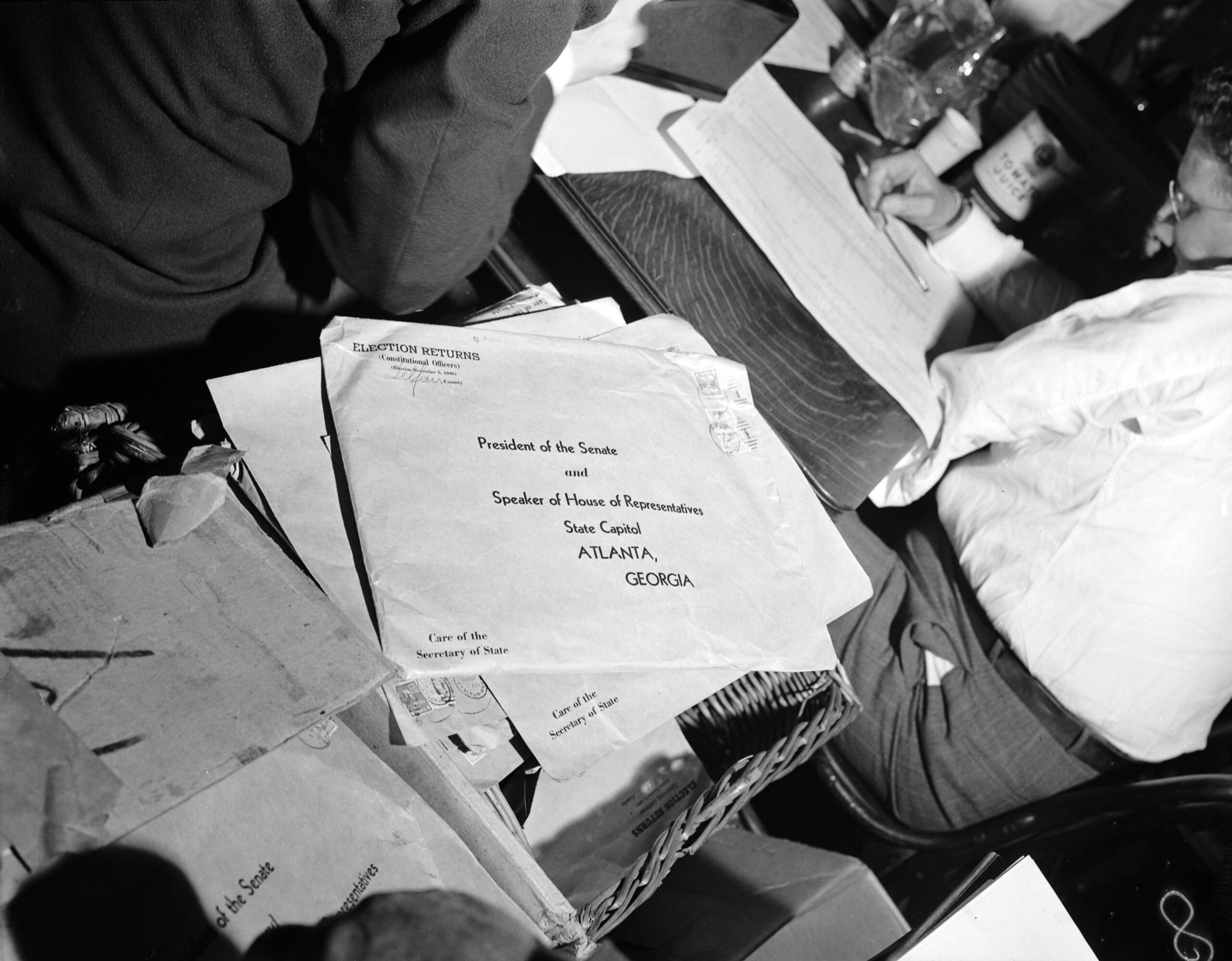
Envelope in the Capitol building from the Georgia Secretary of State’s office marked “Election Returns.” | VIS 82.493.30, Kenneth Rogers Photograph Collection, Kenan Research Center at Atlanta History Center
As the night went on and tensions rose, liquor began to flow freely among civilians and legislators alike. Elected officials on both sides of the aisle attempted to instigate verbal and physical fights. In an interview with Herman Talmadge years later, he alleged that some members of the state senate administered “knock out drops” to one another’s unattended drinks.
Amid the woozy one-liners and dizzying series of convoluted political maneuvers on the floor of the legislature, Talmadge was elected governor, and sworn in at 2 o’clock in the morning on January 15, 1947.
A Box of Ballots
When Talmadge and his entourage headed to the governor’s office on the second floor of the Capitol the following morning, they were met by sitting governor Arnall who refused to vacate the offices. In a 1996 interview with Talmadge, he recalled “8,000 to 10,000 people that were friends of ours, all at the Capitol” on the night of the inauguration.
“Some of them were mad as the devil and some of them had been imbibing.” A fistfight broke out among the pro- and anti-Talmadge factions. Two of Arnall’s aids were “roughed up by a mob,” and furniture was smashed.
Talmadge eventually climbed onto a desk and encouraged the crowd to head home. Arnall was escorted out, and Talmadge changed the locks.
But Arnall did not go quietly into that good night. Instead, he set up his desk in the rotunda of the Capitol where he conducted business. Talmadge reported to work with a .38 caliber in his pocket.
About That Box of Ballots . . .
As Talmadge settled into his office (and Arnall into the rotunda), journalist George Goodwin scrutinized the Capitol vault. Six weeks after the inauguration, Goodwin located the write-in list from the surprise Telfair County delivery. After reviewing the list of 58 voters, he noticed something odd—34 of them were listed alphabetically, as if copied directly from the voter roll.
“It appeared impossible that 34 citizens anywhere could have appeared at the polls and voted in alphabetical order, starting with the first letter and stopping abruptly at K.”
Goodwin travelled to Telfair County and attempted to visit each of the voters listed, only to discover that some had moved away, several claimed not to have cast a ballot, and—most importantly—that many of them were dead.
The stories Goodwin uncovered about the 1946 Three Governors Controversy earned him a Pulitzer Prize in 1948 for local reporting.
In March 1947, with Goodwin’s reports circulating and Melvin Thompson waging a legal battle, the Georgia Supreme Court ruled that Thompson, as the lt. governor at the time of Talmadge’s death, was the rightful successor to the governor’s office.
But the fight was not over. While declaring Thompson the victor, the Supreme Court also ruled that a special election would take place the following year, 1948. On hearing the court’s decision, Talmadge vacated the Capitol with little fanfare and immediately launched his bid for the 1948 special election.
Talmadge defeated Thompson in the 1948 primary and won the general election with 97.51% of the vote.
The events bridging 1946 and 1947 in Georgia were emblematic of the age. The loss signaled the last time a member of the anti-Talmadge faction would hold the office of governor. During his time in office, Herman Talmadge remained a staunch and outspoken supporter of racial segregation.
Talmadge’s election as governor in 1948 and again in 1950 illustrate the popularity of his segregationist message among white Georgia voters at the time, who had outsized representation through methods of suppressing Black and minority voters, such as the county unit system. When Talmadge was elected U.S. senator from Georgia in 1956, he continued to oppose the Civil Rights Movement from his desk in Washington. When President Lyndon B. Johnson signed the 1964 Civil Rights Act, Talmadge and a cohort of other Southern senators boycotted the 1964 Democratic National Convention.
Herman Talmadge’s ascent to the office of U.S. Senator continued the Talmadge faction’s political dominance through the 1960s—an outcome that was aided and strengthened by results of the Three Governors Controversy.
Additional resources.
Buried Truths | WABE
Emory Magazine
Atlanta Journal-Constitution
Department of the Interior | National Parks Service
The Conversation
Georgia Bar Journal
Charles S. Bullock III, Scott E. Buchanan, and Ronald Keith Gaddie, The Three Governors Controversy: Skullduggery, Machinations, and the Decline of Georgia’s Progressive Politics (Athens: University of Georgia Press, 2015)



